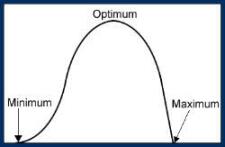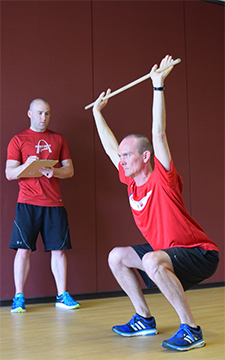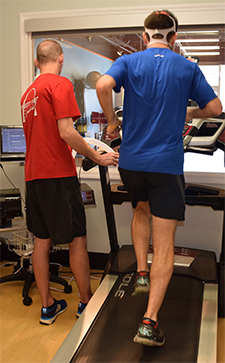Maximum Versus Optimum
One of my favorite lessons for runners is the difference between maximum and optimum. These two words have different meanings, but all too often are used synonymously. Maximum is the greatest amount possible.  Optimum is the best or most favorable amount. As goal-oriented people, runners often want to push to their maximum day in and day out. That sounds great, but our bodies cannot constantly give their maximum without consequences and negative repercussions. For example, you can’t start a marathon at maximum speed and expect to maintain that pace through the finish. Instead, you start at the optimum pace.
Optimum is the best or most favorable amount. As goal-oriented people, runners often want to push to their maximum day in and day out. That sounds great, but our bodies cannot constantly give their maximum without consequences and negative repercussions. For example, you can’t start a marathon at maximum speed and expect to maintain that pace through the finish. Instead, you start at the optimum pace.
How do we find optimum then, Coach? Good question. There are a few different ways to help alleviate wasted energy and effort. We regularly learn things through trial and error, but why waste precious time playing seek-and-destroy? Instead, focus your training and avoid some of the speed bumps that can pop up along the way.
 The most common reason for derailed training is injuries. What if there was a way to help identify weaknesses, or tendencies, that could develop into an overuse injury? A Functional Movement Screening identifies poor muscle activation patterns and compensations. Most overuse injuries are caused by muscle compensations where the compensating muscle gets overworked and gives us the finger. By identifying which muscles are actually working versus those that should be working, we can address those issues before they develop into injuries. In other words, a Functional Movement Screening, or FMS, can help tell us which muscles are working well and which ones need to improve their functionality. Functional Movement Screenings have been very popular in the professional sports world for the past decade. Now they are gaining traction among high school, college, and goal-oriented recreational athletes.
The most common reason for derailed training is injuries. What if there was a way to help identify weaknesses, or tendencies, that could develop into an overuse injury? A Functional Movement Screening identifies poor muscle activation patterns and compensations. Most overuse injuries are caused by muscle compensations where the compensating muscle gets overworked and gives us the finger. By identifying which muscles are actually working versus those that should be working, we can address those issues before they develop into injuries. In other words, a Functional Movement Screening, or FMS, can help tell us which muscles are working well and which ones need to improve their functionality. Functional Movement Screenings have been very popular in the professional sports world for the past decade. Now they are gaining traction among high school, college, and goal-oriented recreational athletes.
A VO2 Max test is another resource that can help us focus our intensity levels when training. A VO2 Max tests answers the age-old question, “How hard should I be running?” by providing an athlete's unique cardiovascular profile.  It tells us where we're doing well and where we can improve. By optimizing our training intensity levels, we can weed out a lot of the "junk" training that litters our schedules. Why guesstimate your optimal heart rate when a VO2 Max test can give you the correct heart rate zones based on your specific physiology?
It tells us where we're doing well and where we can improve. By optimizing our training intensity levels, we can weed out a lot of the "junk" training that litters our schedules. Why guesstimate your optimal heart rate when a VO2 Max test can give you the correct heart rate zones based on your specific physiology?
One of the most common questions we receive at the Training Center is "How much should I eat?" But there is no blanket statement about how much anyone should eat. A Caloric Expenditure test, however, will reveal the rate at which your body burns calories, eliminating the guessing game of how many calories you should eat or whether you have a fast or slow metabolism. A Caloric Expenditure, or CE, test shows your exact metabolic rate. To achieve a goal, you need to know two things: your starting point and your destination. By finding your starting point, you can optimize your route to achieving your goals.
Our goals are positioned down a long road, and we must travel the optimum distance and at the optimum intensity to reach them. We've all heard the phrase, “Work smarter, not harder.” Now is the time to put that truism to work. Too many dreams have been dashed by overzealous training and racing schedules. By finding your optimum training intensity, you will experience a much happier, healthier, and satisfying running career.
Good Luck and Happy Racing.
Coach Cary
 Tim Cary is FLEET FEET's Assistant Training Manager, coach of the FLEET FEET-sponsored Runnababez Elite team, and manager of the FLEET FEET Racing Team. Over his 20 years of coaching, Tim has coached athletes to three national team championships, five national individual championships, two national records, and numerous All-American and All-State honors. Click here to receive Tim's weekly article via email.
Tim Cary is FLEET FEET's Assistant Training Manager, coach of the FLEET FEET-sponsored Runnababez Elite team, and manager of the FLEET FEET Racing Team. Over his 20 years of coaching, Tim has coached athletes to three national team championships, five national individual championships, two national records, and numerous All-American and All-State honors. Click here to receive Tim's weekly article via email.
Connect With Us
see the latest from Fleet Feet St. Louis